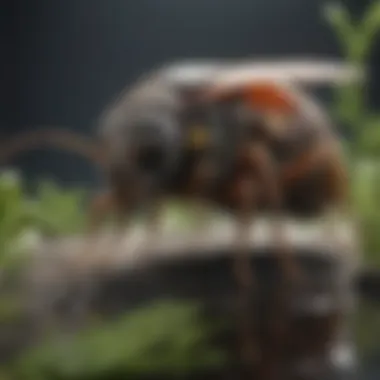Trihill Management: A Deep Dive into Pest Control


Intro
Trihill management plays a vital role in pest control, evolving from traditional methods to more sophisticated strategies in today’s environmental context. This article aims to explore the complexities involved in managing pest populations effectively while aligning with sustainability principles. Understanding these practices can empower homeowners, pest control professionals, and students by providing insights into effective Integrated Pest Management (IPM).
An appreciation of pest identification sets the foundation for effective management. It also helps to differentiate between various pests and to determine appropriate control measures. The following sections will detail essential aspects of pest management, including identification, prevention methods, and relevant DIY pest control solutions.
Prelude to Trihill Management
Trihill Management is an essential aspect of pest control that integrates various methodologies to address pest issues sustainably. Understanding this topic is crucial, especially for homeowners and pest control professionals. The essence of Trihill Management lies in its approach to balancing human needs with environmental considerations. This balance is what makes it relevant in today's world, where ecological awareness is increasing.
One key benefit of Trihill Management is its focus on integrated pest management strategies, which aim to minimize the use of harmful chemicals. Homeowners can significantly reduce the risks associated with conventional pest control while maintaining effective solutions. Moreover, this management approach fosters healthier living environments, contributing to both human and ecosystem well-being.
Considerations for Trihill Management include identifying the pests accurately and understanding their roles in the ecosystem. Every pest has a function, and many contribute positively to the environment. Therefore, it is necessary to consider these aspects instead of solely focusing on eradication. This understanding sets the stage for a more nuanced and effective method of dealing with pest issues.
"Trihill Management emphasizes the importance of ecological balance and sustainability in pest control efforts."
In this section, we will detail the concept of Trihill Management, providing clarity on its definitions and historical context.
Key Principles of Trihill Management
Trihill Management embodies a systematic approach to integrated pest management. Understanding its key principles is essential for enhancing efficacy in pest control measures. Trihill Management not only addresses ecological balance but also encourages sustainability and the use of integrated pest management strategies. These principles guide practitioners in making informed decisions that align with environmental standards and community expectations.
Ecological Balance
Establishing an ecological balance is vital in Trihill Management. It refers to the harmonious coexistence of pest populations, natural predators, and their habitats. This balance ensures that pest control methods do not disrupt the ecosystem's natural processes. When implementing pest management strategies, the focus should be on reducing pest populations to manageable levels without causing harm to beneficial species.
In this regard, several techniques can be employed:
- Monitoring pest populations to ascertain their impact on the environment.
- Using biological control methods where natural predators help keep pest numbers low.
- Employing habitat manipulation to promote environments favorable for beneficial organisms.
"Without a balanced ecosystem, pest management becomes a reactive rather than a proactive approach."
Sustainability in Practices
Sustainability in practices is a cornerstone of Trihill Management. This principle emphasizes the responsible use of resources to ensure longevity in pest control efforts while protecting the environment. Sustainable practices reduce dependency on chemical pesticides and promote methods that have minimal adverse effects on the ecosystem.
To achieve sustainability, professionals can contribute through:
- Implementing crop rotation and diversification to enhance soil health and reduce pest proliferation.
- Utilizing organic pest control options that align with environmental standards.
- Educating homeowners on practices like maintaining clean yards to deter pests without harmful chemicals.
These efforts not only protect the environment but also benefit the community by fostering safer living spaces.
Integrated Pest Management Strategies
Integrated Pest Management (IPM) strategies are pivotal in Trihill Management. These strategies involve a combination of techniques that assess pest problems and apply appropriate solutions. The core of IPM is to use an array of methods to control pests with the least risk to people, property, and the environment.
Key elements of IPM include:
- Prevention: Proactively managing environments to prevent pest infestations.
- Monitoring: Keeping track of pest populations to decide if control measures are needed.
- Control strategies: Using a mix of mechanical, biological, and chemical methods tailored to the specific pest situation.
- Evaluation: Continuously assessing the effectiveness of implemented strategies to improve future pest management efforts.
These strategies effectively reduce the reliance on chemical solutions, thereby mitigating potential health risks and environmental damage.
Assessing Pest Populations
Assessing pest populations is a crucial aspect of Trihill Management. Understanding the dynamics of pest presence and behavior can determine the effectiveness of pest control methods. If homeowners and professionals assess pest populations accurately, they can effectively tailor their pest management strategies. This focused approach can minimize damage to properties and protect the environment while ensuring the control efforts are both effective and sustainable.


Identification of Pests
Identifying pests is the first step in assessing pest populations. Different pests require different management strategies. Accurate identification ensures the most effective control methods are utilized. For instance, distinguishing between termites and carpenter ants is vital. These insects may look alike but require different approaches for management.
Common methods for identification include:
- Visual Inspection: Regular checks in common pest hotspots such as basements or attics.
- Traps: Using sticky traps can help catch pests and provide clues for identification.
- Damage Evaluation: Understanding the type of damage can lead to proper pest identification.
By accurately identifying pests, homeowners can make informed decisions that reduce the reliance on broad-spectrum pesticides. This precision minimizes harm to beneficial insects and the environment.
Population Dynamics and Surveillance
Population dynamics refers to the changes in pest populations over time. Factors affecting these dynamics include food availability, weather conditions, and natural predators. Surveillance is essential in monitoring these changes. It helps in understanding pest life cycles and behaviors. Regular monitoring leads to timely interventions that can control populations before they reach damaging levels.
Key benefits of population dynamics study include:
- Early Detection: Identifying pest surges before they escalate.
- Understanding Life Cycles: Recognizing the breeding patterns aids in timing management practices effectively.
- Resource Allocation: Targeting specific areas or times for intervention based on population trends.
Maintaining an organized surveillance plan, including scheduled checks and immediate reaction strategies, improves overall pest management efficacy.
Data Collection Methods
Data collection is foundational in assessing pest populations. Various methods can be employed for effective data gathering. Each method contributes uniquely to the understanding of pest dynamics.
Some effective data collection methods include:
- Field Observations: Monitoring pest activity through observational studies.
- Surveys and Questionnaires: Collecting homeowner insights about pest sightings or damages over time.
- Use of Technology: Devices such as smart traps or sensors can provide real-time data.
- Historical Data Analysis: Examining previous pest presence and control outcomes can inform current strategies.
Implementing a combined approach will yield the best results. By integrating various data sources, homeowners can gain a comprehensive view of the pest situation. This helps in deciding on the appropriate management techniques tailored to specific pest issues.
Understanding pest populations leads to better pest management strategies, ensuring health and safety in residential environments.
Management Techniques and Tools
The management techniques and tools are crucial for effective Trihill management. These methods play a significant role in successfully controlling pest populations while maintaining ecological balance. By adopting various techniques, homeowners, pest control professionals, and agricultural entities can implement strategies tailored to their specific needs. This article section emphasizes the importance of selecting the appropriate methods and tools to ensure a productive and environmentally responsible pest management system.
Physical and Mechanical Controls
Physical and mechanical controls are integral components of pest management. These methods include barriers, traps, and mechanical devices designed to prevent pests from entering or damaging properties. One of the main benefits of these approaches is that they minimize the use of chemicals, which can have adverse environmental effects.
Common examples include:
- Barriers: Fences, netting, and mulch can inhibit pest access.
- Traps: Pheromone traps and bait traps capture pests without chemicals.
- Mechanical Devices: Vacuum devices and insect vacuums gather pests directly.
These controls require careful planning and consistent monitoring to ensure effectiveness. They can greatly benefit homeowners seeking immediate solutions to pest problems without resorting to chemical treatments.
Biological Control Methods
Biological control methods offer an eco-friendly solution to pest management. This approach relies on the introduction of natural predators or parasites to control pest populations. Ladybugs, parasitic wasps, and nematodes are examples of beneficial organisms used to manage common pests.
Some benefits of biological control include:
- Reduction of pest populations with less ecological disruption.
- Promotion of biodiversity within an ecosystem.
- Long-term solutions that can continue to contribute to pest management over time.
However, implementing biological control needs careful consideration. Identifying the right organism and understanding its behavior is essential. A mismatch can lead to ineffective results. Also, it is important to monitor the effects on the entire ecosystem to prevent unintentional consequences.


Chemical Treatments and Safety
Chemical treatments in pest management should always be approached with caution. There are situations where chemical applications are necessary to manage invasive pest populations effectively. However, ensuring the safety of both humans and the environment is critical.
Some vital points regarding chemical treatments include:
- Selection of Products: Use pesticides that are specific to the pest and with minimal non-target effects.
- Application Techniques: Follow label directions strictly for proper application and safety.
- Safety Measures: Use protective gear and ensure pets and children are away during applications.
It is essential to stay informed about regulations governing pesticide use. Compliance with local laws ensures the safety and health of the community. Ultimately, awareness of the implications of chemical treatments allows for informed decisions regarding pest management.
Effective pest management combines multiple techniques, minimizing risks while enhancing control.
By integrating various management techniques and tools, homeowners can create a robust pest management system. Understanding the strengths and limitations of each method is key to achieving successful outcomes in Trihill management.
Environmental Considerations in Trihill Management
The environmental considerations in trihill management are crucial for understanding the broader impact of pest control measures. As pest management evolves, it is essential to integrate approaches that consider the ecosystem as a whole. The following sections explore how these considerations affect non-target species, the regulatory framework involved, and the implementation of sustainable practices.
Impact on Non-target Species
One significant aspect of trihill management is its impact on non-target species. Non-target species refer to organisms that are not the focus of pest control but may be affected by the methods used. Protecting these species is vital for maintaining ecological balance. If pest control strategies harm beneficial insects, birds, or even soil organisms, this can lead to unexpected ecological repercussions. For instance, neonicotinoid pesticides have been linked to declines in bee populations, which play a crucial role in pollination. Thus, identifying effective yet selective methods in pest management is paramount.
Regulatory Framework and Compliance
Adhering to regulations is another critical component of environmental considerations in trihill management. Countries establish regulatory frameworks to guide pest control practices, ensuring that they are safe for the environment and public health. Compliance with regulations such as the Environmental Protection Agency’s (EPA) guidelines in the United States is necessary for responsible pest management. These regulations dictate proper usage, labeling, and safety of pesticides, providing a safety net against potential negative impacts on ecosystems. Furthermore, understanding these frameworks helps homeowners and professionals alike make informed decisions.
Sustainable Practices in Pest Management
The adoption of sustainable practices is a cornerstone of effective trihill management. Implementing sustainable methods, such as integrated pest management (IPM), emphasizes long-term prevention of pests through a combination of techniques. These techniques may include cultural practices, biological control, and minimal use of chemical pesticides. By applying sustainable practices, homeowners not only protect the environment but also reduce their dependence on harmful substances. Utilizing natural predators or planting pest-resistant plant varieties can be great strategies to minimize potential ecological disruption.
"Integrating pest management approaches can preserve beneficial species while minimizing negative impacts on the ecosystem."
The ongoing commitment to environmental considerations in trihill management ultimately fosters healthier and more resilient ecosystems. By understanding the relationship between pest control and the environment, homeowners can make better choices that align with sustainable practices.
Case Studies of Effective Trihill Management
In this exploration of Trihill Management, understanding real-world applications is crucial. Case studies provide practical insight into how various strategies can be effectively implemented in different contexts. They serve as illustrative examples, showcasing the benefits and potential challenges of Trihill Management practices. This section will detail residential applications, commercial implementations, and agricultural settings. Each case highlights the importance of adaptability, informed decision-making, and innovative approaches in pest management.
Residential Applications
Residential settings often require tailored pest management solutions that consider the unique environment of each home. Effective case studies in this area reveal various successful strategies.
- Preventive Measures: Homeowners can take proactive steps to prevent pest infestations. Using natural repellents, maintaining cleanliness, and sealing entry points are essential.
- Traps and Barriers: Physical barriers such as screens on windows and doors can significantly reduce pests. Trapping methods, such as sticky traps, help monitor pest populations without chemicals.
- Case Example: In a suburban neighborhood, families adopted a community-wide initiative combining various methods. Results showed a 30% decrease in common household pests within one season, showcasing the effectiveness of collaboration and community awareness.
Commercial Implementations
Businesses face different pest challenges compared to residential locations. Effective management is vital for maintaining a safe environment for customers and employees. Here are noteworthy considerations:
- Integrated Pest Management: A well-rounded approach that combines prevention, monitoring, and control methods tailored to the business's needs.
- Regular Audits: Routine inspections help identify potential pest issues before they escalate. Training staff in pest recognition fosters a proactive culture.
- Case Example: A local restaurant faced repeated rodent issues. Implementing an integrated approach, which included regular training for staff and the introduction of monitoring devices, led to a 50% reduction in pest sightings over several months. This emphasized the importance of staff involvement and systematic monitoring.
Agricultural Settings
Agricultural environments present unique challenges in pest management. Effective case studies demonstrate how sustainable practices can lead to successful outcomes:
- Crop Diversity: Rotating crops and planting pest-resistant varieties can naturally deter pests. This method enhances soil health, providing a dual benefit.
- Biological Control Agents: Incorporating beneficial insects can keep pest populations in check without relying solely on chemical treatments.
- Case Example: A wheat farm adopted crop rotation along with natural predators to mitigate locust damage. The integrated approach not only minimized losses but also improved yield by 25% without additional chemical inputs. This case illustrates the potential for sustainable practices in farming settings.


These case studies underline that effective Trihill Management is not a one-size-fits-all solution. Each scenario demands tailored strategies that consider environmental, social, and economic factors. By analyzing these real-world applications, stakeholders can draw valuable lessons and implement best practices in their own pest management efforts.
"Learning from past applications offers a valuable framework for future success in pest management."
Through these examples, it becomes clear that progress in Trihill Management relies on informed strategies and collaborative efforts.
Future Directions in Trihill Management
The realm of Trihill Management faces a compelling future shaped by emerging technologies, educational initiatives, and evolving research opportunities. Understanding these future directions is essential for homeowners and pest control professionals alike, as they aim to adapt to environmental changes, evolving pest challenges, and heightened consumer awareness. Integrating these aspects not only enhances pest control practices but also influences eco-conscious decision-making among clients.
Emerging Technologies and Innovations
Technological advancement plays a crucial role in reshaping the landscape of Trihill Management. Innovations are becoming more prevalent, leading to smarter pest control solutions. For instance, the advent of drone technology allows for effective monitoring of large areas, reducing pesticide use and targeting pest populations more precisely.
Additionally, the use of artificial intelligence and machine learning algorithms now enables professionals to analyze pest behavior and environmental conditions with greater accuracy. Such technologies help in making informed decisions quickly.
Key benefits include:
- Enhanced accuracy in pest detection and monitoring.
- Reduction in environmental impact through targeted applications.
- Increased efficiency of pest control measures.
"Embracing technology is not just a trend; it is transforming approaches to pest management into a science of precision."
Public Awareness and Education Efforts
Increasing public awareness about Trihill Management is vital. Educating homeowners about integrated pest management strategies ensures they make informed choices. Workshops, informative blogs, and community programs can help disseminate knowledge about sustainable practices. Such initiatives could empower individuals to recognize and address pest issues responsibly, fostering a culture of proactivity rather than reaction.
Pest control professionals also need continuous training to stay updated on the latest methods and technologies.
Efforts could include:
- Hosting local seminars focused on pest identification and management.
- Developing easy-to-read informational materials for households.
- Using social media platforms for sharing best practices and tips.
Research Opportunities and Trends
As the pest control field evolves, research will become pivotal in addressing challenges in Trihill Management. Notably, studies examining the effects of climate change on pest behavior and ecology are on the rise. Understanding these dynamics is crucial to predicting pest outbreaks and developing adaptive management strategies.
Research can explore:
- The implementation of more effective and environmentally friendly pest control products.
- Long-term effects of integrated pest management on ecosystems.
- The socio-economic impact of pest control methods on household budgets.
The End
The conclusion serves as a pivotal section in this article, encapsulating the multifaceted elements of Trihill Management. Its importance lies in synthesizing the insights gained from the previous sections. Through comprehensive exploration, we highlighted the core principles, innovative techniques, and environmental considerations that are critical in pest management.
Summarizing Key Insights
The insights garnered throughout this discourse focus on the significance of sustainability and ecological balance within Trihill Management. Homeowners and pest control professionals alike must recognize that effective pest management is not merely about eradication. It involves understanding pest populations, implementing integrated pest management strategies, and being aware of the impacts on non-target species.
- Ecological Balance is essential to maintaining a healthy environment.
- Sustainability in Practices ensures that methods used today do not endanger future generations.
- Technological Innovations are reshaping how we approach pest management, making practices more efficient and environmentally friendly.
Furthermore, we discussed practical case studies demonstrating the successful application of these principles in various settings, stressing the adaptability of Trihill Management strategies.
Final Reflections on Trihill Management
In concluding this exploration, it becomes evident that Trihill Management is a vital component of responsible pest control. As challenges for pest management evolve, so too must the strategies employed. Therefore, ongoing education and public awareness are essential for effective implementation.
Homeowners must engage with the principles of Trihill Management, realizing that every action taken in pest management holds broader implications for ecological health. This approach fosters not only improved living conditions but also contributes to a more sustainable lifestyle.
The reflection on these concepts underlines the importance of informed decision-making in pest control, which can lead to positive outcomes for both people and the environment. Through knowledge and application of Trihill Management principles, individuals can play a significant role in enhancing their living spaces while promoting ecological integrity.
"Trihill Management encapsulates more than pest control; it embodies a commitment to ecological health and sustainable living."
By understanding and implementing these principles, we position ourselves as stewards of our environment, capable of balancing the needs of our homes with the welfare of the ecosystem.















